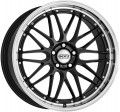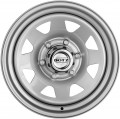Rim width
Wheel rim width. This parameter determines the width of the tyre profile that can be used with this disc. When purchasing tyres, it is worth considering separately that the width of the disk should be less than the width of the tyre profile by 25 – 30%.
Size
Diameter of the wheel rim. Each car has its own recommendations for the wheels size it is usually indicated in the documentation. In addition, this parameter must match the tyres inner diameter used if the wheels are purchased separately. The most popular sizes are
15",
16",
17", for SUVs and powerful sports cars —
18",
19" and
20". Don't forget about small
14", and giants
21",
22" and more.
Bolt pattern diameter
The diameter of the conditional ring along which the mounting holes on the disk are located. Measured at the centers of the holes. This parameter must exactly match the corresponding wheel hub parameter. Together with the number of mounting holes, it forms a bolt pattern (PCD). The most popular values are 4 and 5 bolt discs, with corresponding PCD values:
4x98,
4x100,
4x108,
4x114.3,
5x100,
5x105,
5x108,
5x110,
5x112,
5x114.3,
5x115,
5x120,
5x130. For 6-bolt discs, the most common bolt pattern is
6x139.7.
Offset
Departure is the distance from the plane passing through the place where the wheel is attached to the hub, to the plane passing through the middle of the landing width. Positive overhang values mean that the hub is on the outside of the middle of the disc,
negative values mean that the hub is recessed "deep" into the wheel. For each car model, there is an individual departure value that is optimal for stability and controllability.
Centre bore diameter
The diameter of the centre hole must match the diameter of the centering lug on the vehicle hub. It may also be larger; then adapter rings are used to install the wheel.
Type
The type of disc determines the technology used in its production, which affects both the appearance and strength characteristics.
—
Cast. The production technology of alloy wheels gives a wide scope for a wide variety of design solutions. At the same time, however, such disks are prone to the appearance of microcracks due to wear, break under strong impacts and are difficult to repair.
—
Forged. The most durable and corrosion resistant disc type. The safest, because. withstand even very strong impacts without destruction. Their disadvantages are high cost and design limitations due to production technology. Against the background of high cost, manufacturers came up with a new type — something between forged and cast. A kind of
forged hybrid(Flow Forged, Flow Forming, Hybrid Forged), which is more durable than cast ones, but more budgetary than forged ones.
—
Forged (hybrid). Hybrid forging technology (from the English. "Hybrid Forged") involves the manufacture of alloy wheels under pressure. The result is lightweight wheels with an attractive design and precise geometry. At the same time, the structure of the Hybrid Forged metal approaches in terms of its strength characteristics to forged steel.
—
Teams. The composite disk consists of a forged rim and a cast "pla
...te" fastened together with titanium bolts. This allows you to combine the advantages of both technologies, but such disks are very expensive.
— Stamped. The cheapest and most common type of disk — usually, standard "factory" disks are of this type. In such discs, the rim and the disc itself are fastened together by welding. Usually made from steel. They are cheap, easy to repair, and also quite safe, since they most often deform upon impact without breaking. On the other hand, stamped discs are heavy, not very resistant to corrosion, and not very versatile in design.Material
—
Steel. The most common and cheapest disc material. The disadvantages are high weight and low corrosion resistance.
—
Aluminium alloy. Aluminium alloy wheels are lighter than steel wheels, resistant to corrosion, but, accordingly, more expensive. Cast aluminium wheels (see Wheel type) outperform magnesium wheels in strength, but the situation is just the opposite with forged wheels.
Big lip
Usually big lip is large enough to place an object on it.
Rims with big lip make the wheels visually wider, which is typical for powerful sports cars or classics.

